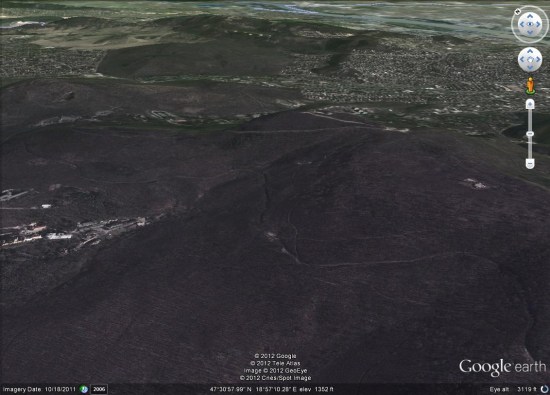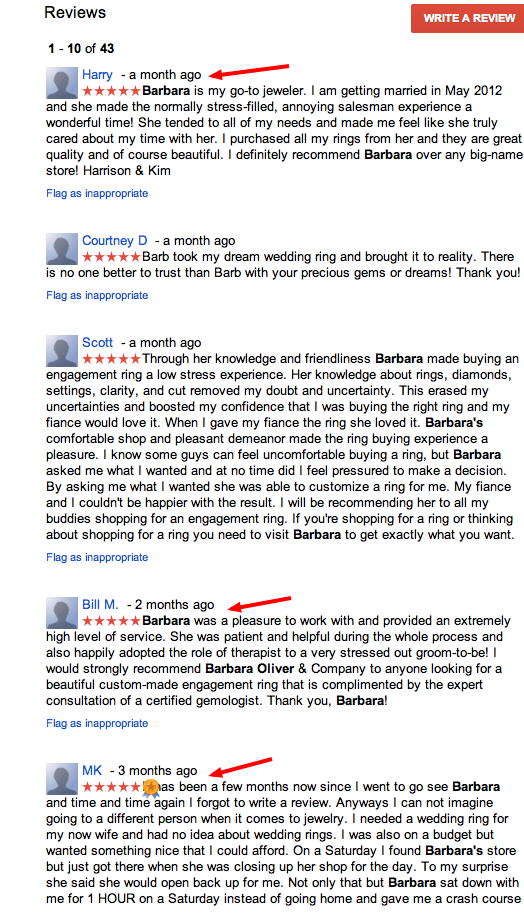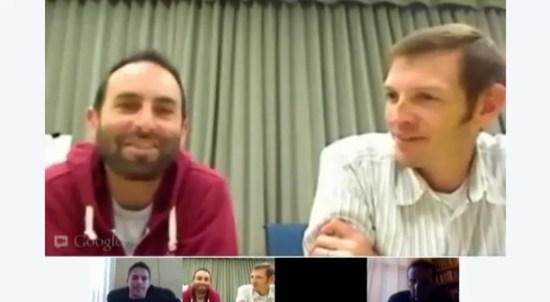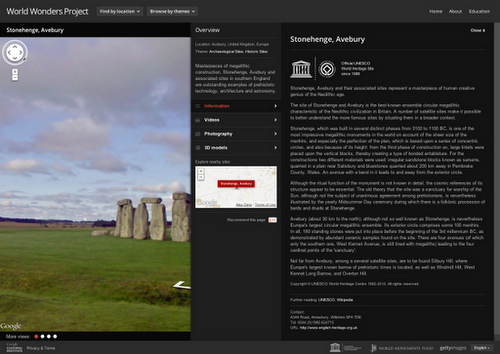Sunday, June 24, 2012
Explore historic sites with the World Wonders Project
I’ve always been fascinated by famous historic and cultural sites from around the world. When I was a child, flipping through encyclopedias while researching for school projects, the thought of exploring these sites was a distant dream. With the new Google World Wonders Project, that dream is now a little closer for students and others around the globe.
The World Wonders Project enables you to discover 132 historic sites from 18 countries, including Stonehenge, the archaeological areas of Pompeii and the ancient Kyoto temples. In addition to man-made sites, you can explore natural places: wander the sandy dunes of Australia’s Shark Bay or gaze up at the rock domes of Yosemite National Park in California.
World Wonders uses Street View technology to take you on a virtual trip to each iconic site. Most could not be filmed by car, so we used camera-carrying trikes to pedal our way close enough. The site also includes 3D models and YouTube videos of the historical places, so you can dig in and get more information and a broader view of each site. We also partnered with several prestigious organizations, including UNESCO, the World Monuments Fund, Getty Images and Ourplace, who provided official information and photographs for many of the sites.
We hope World Wonders will prove to be a valuable educational resource for students and scholars. A selection of educational packages are available to download for classroom use; you can also share the site content with friends.
World Wonders is part of our commitment to preserving culture online and making it accessible to everyone. Under the auspices of the Google Cultural Institute, we’re publishing high resolution images of the Dead Sea Scrolls, digitizing the archives of famous figures such as Nelson Mandela and presenting thousands of artworks through the Art Project.
New Google Earth Imagery - May
Two weeks after their previous update, it appears that Google has just pushed out some more fresh imagery to Google Earth. Thanks to 'hhgygy' for letting us know about it!
 As is almost always the case, you can use Google Maps to determine for sure whether or not a specific area is fresh. This new imagery isn't in Google Maps yet, so you can compare Earth vs. Maps to see what's new; the fresh imagery is already in Google Earth, but the old imagery is still in Google Maps. If you compare the two side-by-side and they're not identical, that means that you've found a freshly updated area in Google Earth!
So far it appear to be a rather small update, and the imagery seems to be rather dark, but see if you can find any other updated areas.
[UPDATED - May 30, 2012 -- 10:33am EST]
As is almost always the case, you can use Google Maps to determine for sure whether or not a specific area is fresh. This new imagery isn't in Google Maps yet, so you can compare Earth vs. Maps to see what's new; the fresh imagery is already in Google Earth, but the old imagery is still in Google Maps. If you compare the two side-by-side and they're not identical, that means that you've found a freshly updated area in Google Earth!
So far it appear to be a rather small update, and the imagery seems to be rather dark, but see if you can find any other updated areas.
[UPDATED - May 30, 2012 -- 10:33am EST]
 As is almost always the case, you can use Google Maps to determine for sure whether or not a specific area is fresh. This new imagery isn't in Google Maps yet, so you can compare Earth vs. Maps to see what's new; the fresh imagery is already in Google Earth, but the old imagery is still in Google Maps. If you compare the two side-by-side and they're not identical, that means that you've found a freshly updated area in Google Earth!
So far it appear to be a rather small update, and the imagery seems to be rather dark, but see if you can find any other updated areas.
[UPDATED - May 30, 2012 -- 10:33am EST]
As is almost always the case, you can use Google Maps to determine for sure whether or not a specific area is fresh. This new imagery isn't in Google Maps yet, so you can compare Earth vs. Maps to see what's new; the fresh imagery is already in Google Earth, but the old imagery is still in Google Maps. If you compare the two side-by-side and they're not identical, that means that you've found a freshly updated area in Google Earth!
So far it appear to be a rather small update, and the imagery seems to be rather dark, but see if you can find any other updated areas.
[UPDATED - May 30, 2012 -- 10:33am EST]
- Greece: Athens, Heraklion, Matala, Viannos, Zakynthos -- thanks 'Andreas'
- Hungary: Budapest (just west of the city)
Tuesday, June 19, 2012
Change to Review Presentation on the Places Page
Google has changed the date information attached to a review and switched from the actual date created to a rough estimate of when it was created. The actual date is still visible if you click through to the reviewer. The change seems to create a greater visual sense of whether reviews are coming in over time.
Now if they would just fix the problem of losing reviews. I find it amazing that Google is continuing to release new local products without fixing underlying issues like the problems they have keeping track of reviews and their lack of transparency in fighting review spam…


Google Earth on mobile devices
Every week, the Google Maps team hosts "office hours" -- a streamed Hangout on Google+ where you can ask the team questions and learn more about what they're working on. Their latest installment featured Josh Livni and Peter Birch, and covered quite a bit about Google Earth. They discussed the history of Google Earth, the history of Earth on mobile, and some of the directions for the future.
 They also referenced Paul van Dinther's excellent work to bring the "Perpetual Ocean" into Google Earth, which was certainly an excellent animation.
Now, thanks to the new "Hangouts On Air" feature that can stream and record Google+ Hangouts, the entire 30 minute video is available for you to view. If you're interested in the current state of affairs of Google Earth and Google Maps, it's a great video to watch.
If you'd like to join them live in the future, stay in touch via the +Google Maps API page on Google+. While you're out there, be sure to add +Google Earth Blog to your circles as well!
They also referenced Paul van Dinther's excellent work to bring the "Perpetual Ocean" into Google Earth, which was certainly an excellent animation.
Now, thanks to the new "Hangouts On Air" feature that can stream and record Google+ Hangouts, the entire 30 minute video is available for you to view. If you're interested in the current state of affairs of Google Earth and Google Maps, it's a great video to watch.
If you'd like to join them live in the future, stay in touch via the +Google Maps API page on Google+. While you're out there, be sure to add +Google Earth Blog to your circles as well!
 They also referenced Paul van Dinther's excellent work to bring the "Perpetual Ocean" into Google Earth, which was certainly an excellent animation.
Now, thanks to the new "Hangouts On Air" feature that can stream and record Google+ Hangouts, the entire 30 minute video is available for you to view. If you're interested in the current state of affairs of Google Earth and Google Maps, it's a great video to watch.
If you'd like to join them live in the future, stay in touch via the +Google Maps API page on Google+. While you're out there, be sure to add +Google Earth Blog to your circles as well!
They also referenced Paul van Dinther's excellent work to bring the "Perpetual Ocean" into Google Earth, which was certainly an excellent animation.
Now, thanks to the new "Hangouts On Air" feature that can stream and record Google+ Hangouts, the entire 30 minute video is available for you to view. If you're interested in the current state of affairs of Google Earth and Google Maps, it's a great video to watch.
If you'd like to join them live in the future, stay in touch via the +Google Maps API page on Google+. While you're out there, be sure to add +Google Earth Blog to your circles as well!
Wednesday, June 6, 2012
Street View drives the Indianapolis Motor Speedway
Growing up in Indiana, my Dad and I shared a love of racing. Not just any kind of racing, but open-wheeled Indy Car racing. Every Memorial Day weekend, we'd get up early and drive from our home in Columbus to the Indianapolis Motor Speedway to watch our favorite spectacle in racing: the Indianapolis 500.
I went to college in Indiana as well, and we were able to keep up the tradition. But when I moved to California, we just weren't able to make it work, and we haven’t been able to attend a race together since.
Luckily, now, I’m an Engineer on Google Street View, and so I’m sure you can imagine my excitement to let the world know that the Indianapolis Motor Speedway is now available through Street View.
Once, Dad managed to get some pit passes, and we wandered around the pits and garages before the race watching the final preparation on the cars, the mechanics scurrying to have everything ready and the drivers doing their pre-race routine. It was really cool and now that's on Street View, also.
From Jim Nabors’ opening song, to the finish line and the milk, this Memorial Day, you’ll find me watching the Indy 500 with my Dad. Explore the track in Street View now and then enjoy the race with us.
Appeals Court Upholds $150K in Punitive Damages for 3 Fake Reviews
Eric Goldman of te Technology & Marketing Law reports out a recent Missouri Supreme Court ruling that upheld a jury award of $150,00 against an ex-partner that wrote 3 fake reviews on Yahoo & Google about his former business. The ruling should cause competitors leaving fake reviews to take note as it substantially eases the burden on the defamed business to not have to demonstrate direct losses (which is impossible on the interent).
Hosto and Mitchell formed two companies together. Eventually, the relationship soured, and they acrimoniously split their empire. Still grousy, Hosto (pretending to be former customers) posted three fake derogatory Google and Yahoo reviews of the company operated by Mitchell. After a John Doe lawsuit, Yahoo disclosed enough information to identify Hosto as the author, and Hosto confessed to the vendetta. Thus, we have the unusual situation where a pseudonymous review author isn’t contesting authorship. After a trial, the jury ruled in favor of Fireworks Restoration’s (the plaintiff’s) defamation claim.
 So far, everything makes sense. But then we get to the remedies, and things get puzzling. The jury awarded $1 in compensatory damages and $150k in punitive damages. On appeal, the court rejects Hosto’s attempts to undermine the jury award: that Mitchell’s company didn’t suffer any reputational harm; that Missouri law doesn’t allow nominal damages; and that the punitive damages were unconstitutionally large in light of the compensatory damages award. As a result, the jury verdict stands.
What to make of this jury verdict? One way to interpret it is that the jury felt that the company suffered no real harm, but Hosto’s behavior was so outrageous it needed to be punished anyway. While the jury’s first conclusion might seem initially counterintuitive, it’s entirely possible that the company suffered no actual harm from the negative fake reviews. Research indicates that a few negative reviews mixed into an otherwise all-positive review set lifts sales conversion because the negative reviews increase the credibility of the positive reviews and help prospective consumers visualize and assess the possible bad outcomes from their wrong choices. Without more detail, for all we know, Hosto could have done his target a favor.
Yet, the judge refuses to put the burden on the plaintiff to find actual lost customers:
So far, everything makes sense. But then we get to the remedies, and things get puzzling. The jury awarded $1 in compensatory damages and $150k in punitive damages. On appeal, the court rejects Hosto’s attempts to undermine the jury award: that Mitchell’s company didn’t suffer any reputational harm; that Missouri law doesn’t allow nominal damages; and that the punitive damages were unconstitutionally large in light of the compensatory damages award. As a result, the jury verdict stands.
What to make of this jury verdict? One way to interpret it is that the jury felt that the company suffered no real harm, but Hosto’s behavior was so outrageous it needed to be punished anyway. While the jury’s first conclusion might seem initially counterintuitive, it’s entirely possible that the company suffered no actual harm from the negative fake reviews. Research indicates that a few negative reviews mixed into an otherwise all-positive review set lifts sales conversion because the negative reviews increase the credibility of the positive reviews and help prospective consumers visualize and assess the possible bad outcomes from their wrong choices. Without more detail, for all we know, Hosto could have done his target a favor.
Yet, the judge refuses to put the burden on the plaintiff to find actual lost customers:
 So far, everything makes sense. But then we get to the remedies, and things get puzzling. The jury awarded $1 in compensatory damages and $150k in punitive damages. On appeal, the court rejects Hosto’s attempts to undermine the jury award: that Mitchell’s company didn’t suffer any reputational harm; that Missouri law doesn’t allow nominal damages; and that the punitive damages were unconstitutionally large in light of the compensatory damages award. As a result, the jury verdict stands.
What to make of this jury verdict? One way to interpret it is that the jury felt that the company suffered no real harm, but Hosto’s behavior was so outrageous it needed to be punished anyway. While the jury’s first conclusion might seem initially counterintuitive, it’s entirely possible that the company suffered no actual harm from the negative fake reviews. Research indicates that a few negative reviews mixed into an otherwise all-positive review set lifts sales conversion because the negative reviews increase the credibility of the positive reviews and help prospective consumers visualize and assess the possible bad outcomes from their wrong choices. Without more detail, for all we know, Hosto could have done his target a favor.
Yet, the judge refuses to put the burden on the plaintiff to find actual lost customers:
So far, everything makes sense. But then we get to the remedies, and things get puzzling. The jury awarded $1 in compensatory damages and $150k in punitive damages. On appeal, the court rejects Hosto’s attempts to undermine the jury award: that Mitchell’s company didn’t suffer any reputational harm; that Missouri law doesn’t allow nominal damages; and that the punitive damages were unconstitutionally large in light of the compensatory damages award. As a result, the jury verdict stands.
What to make of this jury verdict? One way to interpret it is that the jury felt that the company suffered no real harm, but Hosto’s behavior was so outrageous it needed to be punished anyway. While the jury’s first conclusion might seem initially counterintuitive, it’s entirely possible that the company suffered no actual harm from the negative fake reviews. Research indicates that a few negative reviews mixed into an otherwise all-positive review set lifts sales conversion because the negative reviews increase the credibility of the positive reviews and help prospective consumers visualize and assess the possible bad outcomes from their wrong choices. Without more detail, for all we know, Hosto could have done his target a favor.
Yet, the judge refuses to put the burden on the plaintiff to find actual lost customers:
We reject Defendant’s contention that Plaintiff needed to produce testimony from potential customers who opted to turn elsewhere due to the web reviews. With the internet, consumers are able to compare businesses and their wares with unprecedented speed. Interpersonal contact is characteristically absent, so if a consumer declines to engage a business it encounters on the internet, that consumer continues his or her search and the business has no knowledge it has been passed by. As such, it would be unreasonably burdensome to impose upon a business plaintiff the requirement that it locate potential customers that it never knew in order to successfully demonstrate actual damage to its reputation. The deleterious impact of such a constraint far outweighs any benefits it would have in proving reputational harm.In the end, the lesson from this case is obvious and hardly novel: fake competitive reviews are a bad idea. The jury verdict here shows that the jury will punish anyone caught red-handed. At the same time, the jury was quite savvy about the compensatory damages from fake negative reviews. I hope future judges will be equally savvy.
Subscribe to:
Posts (Atom)
